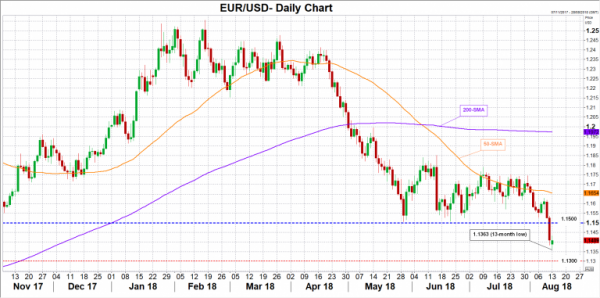While Eurostat’s second GDP growth estimate is expected to confirm on Tuesday that the bloc’s economic growth slowed down in the second quarter, eurozone’s industrial production is anticipated to have picked up steam in June. At the same time in Germany, the ZEW institute is projected to say that economic sentiment in the biggest EU economy has improved but is still negative, with the euro probably bouncing higher if the data indicate a stronger improvement than analysts forecast.
In May, eurozone’s industrial production surprisingly rebounded, printing a growth of 2.4% on a yearly basis, with analysts suggesting now that the measure has further increased positive momentum in June, reaching an expansion pace of 2.6% y/y. The numbers are likely to give some relief to investors who are worried about the EU’s factory performance given the ongoing trade dispute between the US and the rest of the world including the EU, and specifically, Washington’s threats to impose import tariffs on cars and auto parts. A move which if implemented, could hit Germany’s giant auto export market and therefore the bloc’s economic health as the German economy accounts for over a fifth of EU GDP. Recall that Germany’s factory orders tumbled by 4.0% in June on a monthly basis, recording the sharpest decline since March 2017.
Staying in Germany, traders will be closely watching the ZEW indicator of economic sentiment for direction as well. The index is forecast to remain below zero for the third consecutive month in August, probably coming in at -20.7. But compared to July’s bearish mark of -24.7, which was the lowest level reached in almost five years, some investors could speculate that the index has reached a bottom and is now trying to recover.
Turning to forex markets, euro/dollar spiked to a 13-month low of 1.1363 on Monday after the Turkish President called the dispute with the US “an economic war”, raising fears that the battered Turkish lira could put European loans provided to Turkish borrowers under risk. Later in the day, the Turkish central bank announced measures to keep liquidity moving but the euro gained little on the news, crawling marginally above the 1.1400 round level. Should eurozone industrial production and/or German ZEW economic sentiment numbers come in higher than analysts estimate, the euro could touch the 1.1500 key level again where the market found strong support between the end of May and early August.
On the other hand, a miss in data could strengthen bearish actions towards the 1.1300 mark.













